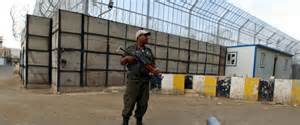Seems while the WH and the DoJ are hell bent on re-writing clemency laws and possibly releasing as many as 1.0 million criminals from domestic prisons, which is a real poke in the eye for Judges, Juries and Congress, shhh, but the same in about to happen it appears at Gitmo.
Barack Obama and Eric Holder seem to be taking the ‘Implied Powers’ of the presidency to a new level never seen before in history and certainly for nefarious reasons.
There has been a recommendation to transfer the worst 48 at Gitmo, which Obama said were too dangerous and must remain in detention, their new home will likely be Gitmo Part 2 located in Sa’ana, Yemen. Oh, we pay for that too.
The facility would hold the 88 Yemeni terrorism suspects, many of whom have not been charged with any crime, still detained at the US military prison in Cuba. Yemenis make up more than half of the 164 men held at Guantanamo, and their stalled repatriation is a key obstacle to closing the prison.
The White House has refused to confirm direct talks with Yemen over the plan. But Caitlin Hayden, a spokeswoman for the National Security Council, said that the US is part of a UN-led group formed in August to help Yemen establish a rehabilitation programme “which could also facilitate the transfer of Yemeni detainees held at Guantanamo”.
Yemen’s human rights minister appealed to the United States and Gulf Arab countries to help fund a $20 million rehabilitation centre that Sanaa says will stop Yemenis released from Guantanamo Bay prison going back to militant activities. Washington halted the repatriation of Yemeni prisoners in 2010 after a man trained by al Qaeda-linked militants in Yemen attempted to blow up a U.S.-bound plane in 2009 with a bomb concealed in his underwear.
Last week President Barack Obama announced the US’s readiness to lift up ban on repatriating Yemeni nationals from Guantanamo Bay top security prison.
Sanaa has put a price tag on the issue, asking Washington and the Gulf capitals to fund construction of a rehabilitation center that will potentially soothe the pains of former extremists and disincline them from armed violence.
“The detainees will be rehabilitated and reintegrated into society,” state news agency Saba quoted Yemen’s President Abd-Rabbu Mansour Hadi as saying. On Tuesday, Hadi shared his views with the US Senator John McCain who is touring the Middle East.
Yemen’s Human Rights Minister Houriah Mashhour told Reuters that the government approved the plan, but needs funding, from $18 to $20 million to bring the project into life.
“The [financial] support that the United States would offer to Yemen in this regard will not be more than what it is [currently] spending to maintain Guantanamo prison,” Mashhour evaluated in an interview on Wednesday.
She also addressed wealthy Arab states of the Persian Gulf, which promoted the power transfer in Yemen in 2011 and helped to stop months-long political instability in Yemen, to sponsor the rehab project.
A large number, if not the majority of the Guantanamo detainees are from Yemen.
Among the 86 Gitmo prisoners already cleared for transfer or release are 56 Yemeni nationals. The next 80 detainees awaiting clearance for transfer have unaccounted for number of Yemenis as well. Many of them are among the 100+ Gitmo prisoners who are on hunger strike, which began sometime in February, demanding to be let out.
Most of them were detained over a decade ago, following the 9/11 terror acts in the US and the American invasion to Afghanistan.
Washington stopped repatriating Yemeni nationals from Guantanamo prison in 2010, following the 2009 incident of an attempted US-bound plane blast. A man who attempted to bring explosives aboard in his underwear had been trained by Al-Qaeda-linked militants in Yemen.
Yemen is one of the most impoverished countries in the Arabian Peninsula, which definitely helps Al-Qaeda cells, which traditionally recruit new members among poverty-stricken population.
The Arab Spring protests in 2011 hit low-lived Yemen particularly hard, putting the country on the verge of a civil war. In the end President Ali Abdullah Saleh was ousted and replaced with his subordinate Hadi.
Though the situation in Yemen has largely stabilized since then, the Islamist insurgency together with Al-Qaeda are still targeting governmental facilities and troops in regular attacks and explosions.
Who is behind this covert move? The answer is Eric Holder’s shadow legal staff. Just a sample of who Barack Obama has said is too dangerous to release but then changed his mind is but one of up to 48 that are soon to be headed to back to Yemen, which by the way is the very location of the al Qaeda meeting with the top jihadis who were so brazen as to publish the video online. The United States did respond with a drone strike however, yet in the end, to empty the cells of Guantanamo and send the detainees to Yemen defies logic…well not to the DoJ or the White House anyway.

